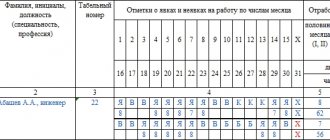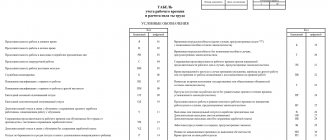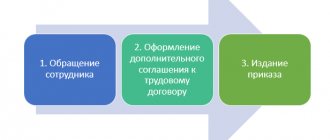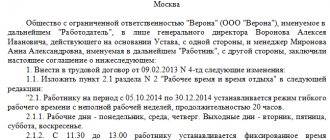When is Form T-13 used?
Every employer is required to keep records of the working hours of its employees (Article 91 of the Labor Code of the Russian Federation).
For this purpose, he can use any form suitable to the peculiarities of his mode of operation, including those developed by himself. There are 2 forms, approved by one resolution of the State Statistics Committee, which can be used for the purposes of recording time worked, either unchanged or modified:
- Form T-12, the 1st section of which is built as a time sheet.
- Form T-13, which, in fact, is called a time sheet.
Form T-13 was approved by Decree of the State Statistics Committee of the Russian Federation dated January 5, 2004 No. 1. You can download it on our website.
The tables of the 1st section of the T-12 form and the T-13 form are very similar, but there are also differences:
- Data on the days of the month related to a specific employee in the T-12 form are arranged horizontally sequentially from the first to the last day. In the T-13 form they are divided into 2 parts (half of the month), which are located under each other.
- Taking into account the fact that for each day, in addition to the number of hours worked, the reason for the employee’s presence or absence at work is indicated, due to the peculiarities of constructing tables in the T-12 form, each person is allocated 2 lines, and in the T-13 form - 4 lines.
- In the final part of the table of the T-13 form there are columns that are missing in the T-12 form. They reflect the codes of payment types and the corresponding accounting account in which accrued wages will be recorded.
You can use any of the above forms. The very fact of its presence is decisive. Without a reliable time sheet, it is impossible to correctly calculate wages.
Read about what replaces wages for individual entrepreneurs in the material “Individual entrepreneurs do not have the right to pay themselves a salary .
Time sheet (Unified form No. T-13, Form according to OKUD 0301008)
Expand ▼
The time sheet (Unified form No. T-13, Form according to OKUD 0301008) corresponds to the resolution of the State Committee of the Russian Federation on Statistics dated January 5, 2004 No. 1 “On approval of unified forms of primary accounting documentation for labor accounting and its payment.”
It is used to record the time actually worked and (or) not worked by each employee of the organization, to monitor employees’ compliance with the established working hours, to obtain data on hours worked, calculate wages, and also to compile statistical reporting on labor. Form No. T-13 is used to record working hours. It is drawn up in one copy by an authorized person, signed by the head of the structural unit, an employee of the personnel department, and transferred to the accounting department. Notes in the Timesheet about the reasons for absence from work, work part-time or outside the normal working hours at the initiative of the employee or employer, reduced working hours, etc. are made on the basis of documents prepared properly (certificate of incapacity for work, certificate of performance state or public duties, written warning about downtime, application for part-time work, written consent of the employee to work overtime in cases established by law, etc.). To reflect the daily working time spent per month for each employee, the timesheet is allocated: in form No. T-13 (column 4) - four lines (two for each half of the month) and the corresponding number of columns (15 and 16). In form No. T-13 (in columns 4, 6), the top line is used to mark the symbols (codes) of working time costs, and the bottom line is used to record the duration of worked or unworked time (in hours, minutes) according to the corresponding codes of working time costs for every date. If necessary, it is allowed to increase the number of boxes to enter additional details according to the working hours, for example, the start and end times of work in conditions other than normal. Working time costs are taken into account in the Timesheet either by completely recording appearances and absences from work, or by registering only deviations (absences, tardiness, overtime, etc.). When reflecting absences from work, which are recorded in days (vacation, days of temporary disability, business trips, leave in connection with training, time spent performing state or public duties, etc.), only codes are entered in the top line in the columns of the Timesheet symbols, and the columns in the bottom line remain empty. Form No. T-13 “Working time sheet” is used for automated processing of accounting data. When drawing up a timesheet in form No. T-13: when recording accounting data for calculating wages for only one type of payment and a corresponding account common to all employees included in the Timesheet, fill in the details “wage type code”, “corresponding account” above the table with columns 7 - 9 and column 9 without filling in columns 7 and 8; when recording accounting data for payroll for several (from two to four) types of payment and corresponding accounts, columns 7 - 9 are filled in. An additional block with identical column numbers is provided for filling out data by types of payment, if their number exceeds four. Report sheet forms in form No. T-13 with partially filled in details can be produced using computer technology. Such details include: structural unit, last name, first name, patronymic, position (specialty, profession), personnel number, etc. — that is, the data contained in the directories of conditionally permanent information of the organization. In this case, the form of the report card changes in accordance with the accepted technology for processing accounting data.
Approval of the procedure for maintaining form T-13
The procedure for filling out the T-13 form may have its own nuances for each specific employer, so it is advisable to consolidate it in the appropriate document (instructions or manual). The following points will need to be reflected in it:
- Appointment of the person (or persons) responsible for maintaining the time sheet.
- The need to maintain separate time sheets by department.
- Approval of additional codes for exits or absences from work.
- Approval of the order of data reflection in the report card: all facts of presence/absence or only absences.
- Determining the order in which data on outputs/non-exits is reflected in complex or non-standard situations.
Filling out form T-13
The header part of the T-13 form provides information about the employer (name, OKPO code, name of department), number and date of the document, and the period for which it was compiled.
The basis for adding an employee to the time sheet is an order for his hiring, and for exclusion - an order for dismissal. The full name of each employee must be indicated in full. All reasons for absence must be documented.
When filling out data for a specific person, the reason for presence/absence is indicated in the 1st top and 3rd lines from the top using an alphabetic or numeric code, and in the lines below them (2nd and 4th) - the number of hours worked. For data on absence in the lines allocated for the number of hours, either zero or nothing is entered. Days that are extra for a particular month are crossed out with an “X”. Weekend o. The length of a normal working day indicated in the timesheet must correspond to the number of hours established in the employee’s employment contract or determined by law (for example, for shortened pre-holiday days). The duration of overtime work is established by order of the employer.
For types of absence counted in calendar days (vacation, sick leave), the mark is affixed in a continuous manner, i.e. including on weekends. Departure/arrival on a day off related to a business trip is noted as a business trip day.
You can download a sample of filling out the T-13 form for an 8-hour working day with a 40-hour working week on our website.
In this example, work takes place on a weekend. It is carried out by order of the manager with the consent of the employee. The order must indicate how this day will be paid: either double (Article 153 of the Labor Code of the Russian Federation), or by providing time off on a working day.
If you have access to ConsultantPlus, check whether you filled out the timesheet correctly. If you don't have access, get a free trial of online legal access.
Read more about payment for work on a day off in the material “Art. 153 Labor Code of the Russian Federation: questions and answers.”
Tank destroyer T.13: stop the Wehrmacht!
Belgian self-propelled gun T.13
, created by installing a good anti-tank gun on a mediocre chassis, in many ways anticipated the tank destroyers of World War II. Despite the fairly large production volume (about three hundred copies), the T.13 failed to have a significant impact on the course of hostilities.
The pre-war concept of the defense of Belgium was positional and relied on a line of powerful forts. This doctrine did not provide for the presence of powerful armored forces - armored fighting vehicles were considered only as an addition to infantry and cavalry units. A dozen ACG 1 medium tanks (Renault AMC 34) and 42 T.15 reconnaissance tanks (Vickers M1934), which were essentially tankettes with turrets, were all that the Belgian army could boast on the eve of the war. The most popular type of armored vehicle was the T.13 light anti-tank self-propelled gun.
Confront the Panzerwaffe
The Belgian army had good artillery, including anti-tank artillery. The latter was based on the 47-mm C.47 FRC Mod 31 cannon. The gun, produced in 750 copies, penetrated 44 mm of armor at a distance of 500 m, and 37 mm at 1000 m. The ammunition included a high-explosive fragmentation projectile weighing 1.66 kg made it possible to use the gun as a means of supporting infantry.
The C.47 FRC Mod 31 gun (modified for installation in a tank turret) was the main armament of the ACG 1 tanks. In addition, the Belgian military considered it as a weapon for a light self-propelled gun intended for mobile anti-tank reserves. The intended use of such a vehicle anticipated the ambush-based tactics of World War II tank destroyers. Being small in size, such a self-propelled gun had to have good mobility, and armor protection could be minimal. A simple and inexpensive combat vehicle could well become widespread - all that remained was to decide on the chassis.
Tank destroyers on the Carden-Loyd Mk VI tankette chassis in the stowed position (gun shields folded back) maquetland.com
In 1931, Belgium acquired six Carden-Loyd Mk VI tankettes. Two of them were converted into self-propelled guns, with one armed with a 47-mm anti-tank gun, and the second with a 76-mm infantry gun. Tests of the second sample were unsuccessful - the lightweight chassis had difficulty withstanding recoil. Therefore, this specimen was also re-equipped with a 47-mm cannon (according to some sources, all six tankettes were converted into anti-tank self-propelled guns). This tank destroyer did not become widespread for several reasons. Firstly, the crew, consisting of only two people, was overloaded with responsibilities. Secondly, the armor protection was clearly insufficient. Thirdly, the dimensions of the Carden-Loyd did not allow for the placement of acceptable ammunition.
Tank destroyer on the Carden-Loyd Mk VI wedge chassis, which became a German trophy. Gun shield in firing position maquetland.com
"Let's take a tractor..."
In 1934, Belgium ordered a batch of Light Dragon Mk I tracked artillery tractors, intended to tow 75-mm Bofors mountain guns in two divisions of the Ardennes rangers. The first batch (21 or 23 tractors) was delivered in an unarmored version, the second (32 vehicles) in an armored version. These tractors looked very attractive from the point of view of conversion into tank destroyers - their increased dimensions compared to a wedge heel made it possible to accommodate not only a gun, but also a crew of three, as well as a completely acceptable ammunition load of several dozen shells. The corresponding project was developed by specialists.
The armored version of the “light dragoon” was taken as the basis. The modification was extremely simple: a double armored half-turret with armament consisting of a 47-mm cannon and a coaxial 7.65-mm FN-Browning machine gun (Belgian version of the M1918 BAR) was installed on the cargo platform. The standard ammunition of the gun consisted of 42 shells (24 armor-piercing and 18 high-explosive fragmentation).
The half-turret theoretically had a circular rotation, but the armor protection of the front part of the hull limited the firing angle to 120º in the rear direction. This was not considered a serious drawback (as well as the partially open turret) due to the planned use of self-propelled guns from ambushes. If necessary, all-round fire was provided, but this required the top armor sheets to be folded back.
Self-propelled gun T.13V1 overcomes the ford Wenkin H. Le canon automoteur T13 // Trucks & Tanks Magazine, 2010, No. 17
The converted tractor was classified as a light tank (Char Leger) and given the designation T.13B1. Weighing 4.8 tons, it could reach highway speeds of up to 40 km/h and had a range of 240 km. The power plant is a Meadows ERT carburetor engine with a power of 51 hp. with manual transmission. The chassis for one side consisted of a front drive wheel and four road wheels interlocked into two bogies.
The armor protection of the T.13V1 was, frankly, weak - the body was covered with sheets 4-6 mm thick, which did not always protect even from small arms fire. The turret armor was more solid - 9 mm.
Projections of self-propelled gun T.13B2 Wenkin H. Le canon automoteur T13 // Trucks & Tanks Magazine, 2010, No. 17
During 1935, all 32 “Light Dragon” Mk I armored tractors were converted into the T.13B1 variant. Next came the turn of their unarmored counterparts, who also turned into “light tanks” T.13B2. The scope of alterations in this case was greater, because it was necessary to armor the hull. In addition, the chassis was strengthened by replacing the road wheels. The gun half-turret had a slightly lower height compared to the T.13V1. Deliveries of T.13V2 were completed in 1937.
Third option
In 1935, Belgium purchased a new batch of tractors from Vickers, this time of a more modern modification - the Light Dragon Mk IID. These vehicles were originally intended to be converted into “light tanks”, designated T.13V3. The Light Dragon Mk IID had a more powerful engine (80 hp), which had a positive effect on mobility. The chassis has undergone significant improvements. Now, for one side, it consisted of a front drive wheel, a rear idler wheel, and four road wheels interlocked in pairs into Horstmann system bogies (each bogie also included one support roller).
Projections of self-propelled gun T.13B3 Wenkin H. Le canon automoteur T13 // Trucks & Tanks Magazine, 2010, No. 17
The T.13V3 received a completely enclosed armored hull and a circular rotating turret - although open at the rear, it was much better protected than the T.13V1 and T.13V2 turrets. The armament remained the same, but the gun's ammunition load was increased to 69 shells. The regular crew now consisted of four people, but three were enough for combat.
General view of the self-propelled gun T.13B3 Wenkin H. Le canon automoteur T13 // Trucks & Tanks Magazine, 2010, No. 17
Production of the T.13B3 at the Familreux plant began in 1937. Before World War II, the entire ordered batch of 194 vehicles was delivered. After the start of the war, the government ordered another 158 tank destroyers. Before the occupation of Belgium, they managed to deliver, according to various sources, from 12 to 50 T.13V3 (a smaller figure seems more likely). Another 24 to 50 tank destroyers from this batch were captured by the Germans right at the factory. Thus, the total number of T.13V3 produced can range from 230 to 294 units.
Service and combat use
According to the plan of the creators of the T.13 self-propelled guns, small units of these self-propelled guns (company level) were supposed to become a kind of “fire brigades”, supporting the classic anti-tank defense as a mobile reserve or acting independently - in those areas where there were no conventional anti-tank guns.
Column of T.13V1 self-propelled guns on the march maquetland.com
The typical organization of the T.13 squadron in the mid-30s was as follows:
- control and utility platoon (2 T.13, 2 motorcycles, including one with a sidecar, 1 light and 3 medium trucks);
- three fire platoons (each - 3 T.13, 3 motorcycles and 2 medium trucks).
Probably, during the mobilization, the organization of the squadrons underwent changes, since most of them had 12 tank destroyers (and even 18 in the squadrons of cavalry divisions).
The crew of the T.13V3 self-propelled gun during field training maquetland.com
During the mobilization, Belgium deployed 18 infantry divisions (6 regular, 6 reserve and 6 second order), two divisions of Ardennes chasseurs and two cavalry divisions. A T.13 squadron with a dozen combat vehicles each was assigned to nine infantry divisions (numbered 1 to 4 and 7 to 11). The cavalry divisions received 18 self-propelled guns, and the 1st division of the Ardennes rangers was given as many as four squadrons (48 self-propelled guns). In addition, the T.13 squadron (12 units) was assigned to two bicycle regiments - the mountain regiment and the 2nd border regiment. The garrison of the Namur fortress received 12 tank destroyers, 10 - Liege, 4 - the gendarmerie. Thus, in total there were 242 tank destroyers in the mobilized units.
Self-propelled guns Т.13В3 during exercises Wenkin H. Le canon automoteur T13 // Trucks & Tanks Magazine, 2010, No. 17
The mobilized Belgian army was supposed to number 800,000 people, but the mobilization plan could not be fully implemented - about 650,000-700,000 people ended up in units. The conflict that flared up in society between the two main ethnic groups - the Flemings and the Walloons - led to a decline in discipline and a deterioration in the moral and psychological state of the army. Nevertheless, the country was preparing for defense.
According to the plans of the Belgian command, the main line of defense was the Dale River and the line of the so-called “New Forts”. But, as you know, the Wehrmacht did an excellent job of breaking through fortifications and overcoming water obstacles. Already on May 10, 1940, German paratroopers captured the largest fort of Eben-Emal, which covered the crossings across the Meuse and the Albert Canal. This allowed the Belgians to be pushed back to the Namur-Antwerp line and to the Ardennes. As a result, Belgium capitulated on May 28.
What role did the T.13 self-propelled guns play in defensive battles? In short, it’s minimal. It is believed that the entire Belgian army was able to destroy only two dozen German tanks (for comparison: in the battles of May 12-14 near Annaud on Belgian territory, the French destroyed up to 160 enemy tanks at the cost of losing 105 of their own). The main reason was the actual refusal to use the T.13 as planned before the war - from ambushes. Attempts to use them as tanks (which the T.13 nominally were) led to heavy losses. Self-propelled guns in small groups (3-4 vehicles each) were thrown into battle to support the infantry, and they were easily knocked out by German anti-tank defenses. The other extreme was the reluctance of some commanders to risk assigned combat vehicles - in an effort to save equipment “for later,” they often missed a real opportunity to cause damage to the enemy.
In addition, in practice, the T.13 turned out to be extremely unreliable machines. For example, out of a dozen self-propelled guns of the 2nd Bicycle Border Regiment, after eight days only four remained on the move. The lack of a radio station also had a detrimental effect - communication between T.13 units was provided by motorcyclist messengers. One of the few successful episodes of combat use of the T.13 was the counterattack at Quatrecht (near Ghent), launched on May 20. Here, thanks to the joint actions of infantry and self-propelled guns, the Belgians managed to push back two German infantry regiments and thereby enable the British units to retreat to Dunkirk.
1/2
Heading1
Heading2
German soldiers inspect a captured T.13B3 maquetland.com
Acquaintance with another trophy - T.13B2 Kucharski BT13, czyli belgijskie remedium na Panzerwaffe // Wojsko i Technika Historia, 2021, No. spec. 3
Several dozen T.13s became German trophies. The few surviving T.13В1 and Т.13В2 were designated Panzerjäger Sfl CL 801(b), and the Т.13В3 - Panzerjäger Sfl CL 802(b). Some of them managed to fight on the side of the new masters at the final stage of the campaign in the West. Subsequently, captured self-propelled guns were used for training purposes, as well as to fight partisans - mainly in the Balkans. The only self-propelled gun that has survived to this day was discovered after the war in Vienna, where it probably ended up with units retreating from the Balkans. Currently, this vehicle, belonging to the T.13B2 modification, is on display at the Royal Army Museum in Brussels.
1/2
Heading1
Heading2
A German serviceman masters captured equipment - self-propelled gun T.13B2 Kucharski BT13, best practice on Panzerwaffe // Wojsko i Technika Historia, 2021, No. spec. 3
T.13B3 from the SS troops maquetland.com
The T.13 tank destroyer was, without exaggeration, an innovative machine.
The idea of installing a fairly powerful anti-tank weapon on a light chassis was in the air in many countries in the 1930s, but only in Belgium was it brought to practical implementation - in other cases everything came down to prototypes or small batches. Alas, T.13 did not live up to the hopes placed on it. The vehicle itself is only partially to blame for this - despite all its shortcomings, with tactically competent use, tank destroyers could cause much more damage to the enemy. Tactical and technical characteristics of self-propelled guns T.13
| T.13V1 | T.13V3 | |
| Crew, people | 3 | 4 |
| Combat weight, kg | 4800 | 5084 |
| Length, mm | 3650 | 3650 |
| Width, mm | 1780 | 1870 |
| Height, mm | 2050 | 2500 |
| Armament | 47 mm cannon, 7.65 mm machine gun | 47 mm cannon, 7.65 mm machine gun |
| Ammunition, shells/cartridges | 42/400 | 69/400 |
| Engine power, hp | 51 | 80 |
| Highway speed | 40 | 56 |
| Cruising range on the highway, km | 200 | 200 |
| Armor thickness, mm: | ||
| frame | 4-6 | 7 |
| tower | 9 | 9 |
Literature:
- Chamber P., Gander T. Anti-Tank Weapons. — New York, 1974
- Kucharski BT13, czyli belgijskie remedium na Panzerwaffe // Wojsko i Technika Historia, 2021, no. spec. 3
- Wenkin H. Le canon automoteur T13 // Trucks & Tanks Magazine, 2010, No. 17
- maquetland.com
Where to get codes for form T-13
The most frequently used presence/absence codes (alphabetic and numeric) are located on the 1st sheet of the T-12 form. If necessary, you can develop additions to them or your own table of such codes.
As payment type codes entered when filling out the final part of the table of form T-13, which is not included in form T-12, for the purpose of data comparability, it is more reasonable to use the codes given in Appendix 1 to the order of the Federal Tax Service of Russia dated September 10, 2015 No. MMV-7- 11/ [email protected] Codes from this application are used when filling out form 2-NDFL.
Sources:
- Labor Code of the Russian Federation
- Resolution of the State Statistics Committee of the Russian Federation dated January 5, 2004 N 1
- Order of the Federal Tax Service of Russia dated September 10, 2015 N ММВ-7-11/ [email protected]
You can find more complete information on the topic in ConsultantPlus. Free trial access to the system for 2 days.
Time sheet
Unified form N T-13 Approved by Decree of the State Statistics Committee of the Russian Federation dated January 5, 2004 N 1
(see Instructions for the use and completion of forms of primary accounting documentation)
————+ ¦ Code ¦ +————+ OKUD form ¦ 0301008 ¦ +————+ according to OKPO¦ ¦ ————————————————— +————+ name of the organization ¦ ¦ ¦ ¦ —————————— ——————————+———— structural unit ————T————-+ ——————+ ¦ Number ¦ Date ¦ ¦ Reporting period ¦ ¦ document ¦ compilation ¦ ¦ ¦ +————+————-+ +———T———+ ¦ ¦ ¦ ¦ from ¦ to ¦ L————+————— +———+———+ ¦ ¦ ¦ L———+——— Timesheet ———T—————T——-T———————————————————— ———T——————+ ¦ Number ¦ Last name, ¦ Timesheet-¦ Notes on attendance and absence from work by day of the month ¦ Worked for ¦ ¦ by ¦ initials, ¦ ny +—-T—-T—T —T—T—-T—T—-T—T—-T—-T—-T—T—T——T—+———T——-+ ¦order¦ position ¦ number ¦ 1 ¦ 2 3 4 5 6 7 8 9 10 11 12 13 14 15 X half a month (specialty) ¦ ¦ ¦ ¦ ¦ ¦ ¦ ¦ ¦ months ¦ ¦ ¦ ¦ , profession) ¦ ¦ ¦ ¦ ¦ ¦ ¦ ¦ ¦ ¦ ¦ ¦ ¦ ¦ ¦ ¦ ¦ ¦ (I, II) ¦ ¦ ¦ ¦ ¦ —+—+—-+—+—-+—+—-+—-+—-+—+—+——+—+———+——-+ ¦ ¦ ¦ ¦ 16 ¦ 17 ¦18 ¦ 19 ¦20 ¦ 21 ¦22 ¦ 23 ¦24 ¦ 25 ¦ 26 ¦ 27 ¦28 ¦29 ¦ 30 ¦31 ¦ days ¦ ¦ ¦ ¦ ¦ ¦ ¦ ¦ ¦ ¦ ¦ ¦ ¦ ¦ ¦ ¦ ¦ ¦ ¦ ¦ +—— ————+ ¦ ¦ ¦ ¦ ¦ ¦ ¦ ¦ ¦ ¦ ¦ ¦ ¦ ¦ ¦ ¦ ¦ ¦ ¦ ¦ clock ¦ +——-+—————+——-+—-+—-+—+ —+—+—-+—+—-+—+—-+—-+—-+—+—+——+—+———T——-+ ¦ 1 ¦ 2 ¦ 3 ¦ 4 ¦ 5 ¦ 6 ¦ +——-+—————+——-+—-T—-T—T—T—T—-T—T—-T—T—-T—-T—-T— T—T——T—+———+——-+ ¦ ¦ ¦ ¦ ¦ ¦ ¦ ¦ ¦ ¦ ¦ ¦ ¦ ¦ ¦ ¦ ¦ ¦ ¦ X ¦ ¦ ¦ ¦ ¦ +—-+—-+— +—+—+—-+—+—-+—+—-+—-+—-+—+—+——+—+———+ ¦ ¦ ¦ ¦ ¦ ¦ ¦ ¦ ¦ ¦ ¦ ¦ ¦ ¦ ¦ ¦ ¦ ¦ ¦ X ¦ ¦ ¦ ¦ ¦ ¦ +—-+—-+—+—+—+—-+—+—-+—+—-+—-+—-+—+—+ ——+—+———+——-+ ¦ ¦ ¦ ¦ ¦ ¦ ¦ ¦ ¦ ¦ ¦ ¦ ¦ ¦ ¦ ¦ ¦ ¦ ¦ ¦ ¦ ¦ ¦ ¦ +—-+—-+—+—+— +—-+—+—-+—+—-+—-+—-+—+—+——+—+———+ ¦ ¦ ¦ ¦ ¦ ¦ ¦ ¦ ¦ ¦ ¦ ¦ ¦ ¦ ¦ ¦ ¦ ¦ ¦ ¦ ¦ ¦ +——-+—————+——-+—-+—-+—+—+—+—-+—+—-+—+—-+—-+— -+—+—+——+—+———+——-+ ¦ ¦ ¦ ¦ ¦ ¦ ¦ ¦ ¦ ¦ ¦ ¦ ¦ ¦ ¦ ¦ ¦ ¦ ¦ X ¦ ¦ ¦ ¦ ¦ ¦ +—-+— -+—+—+—+—-+—+—-+—+—-+—-+—-+—+—+——+—+———+ ¦ ¦ ¦ ¦ ¦ ¦ ¦ ¦ ¦ ¦ ¦ ¦ ¦ ¦ ¦ ¦ ¦ ¦ ¦ X ¦ ¦ ¦ ¦ ¦ ¦ +—-+—-+—+—+—+—-+—+—-+—+—-+—-+—-+— +—+——+—+———+——-+ ¦ ¦ ¦ ¦ ¦ ¦ ¦ ¦ ¦ ¦ ¦ ¦ ¦ ¦ ¦ ¦ ¦ ¦ ¦ ¦ ¦ ¦ ¦ ¦ +—-+—-+—+ —+—+—-+—+—-+—+—-+—-+—-+—+—+——+—+———+ ¦ ¦ ¦ ¦ ¦ ¦ ¦ ¦ ¦ ¦ ¦ ¦ ¦ ¦ ¦ ¦ ¦ ¦ ¦ ¦ ¦ ¦ +——-+—————+——-+—-+—-+—+—+—+—-+—+—-+—+—-+— -+—-+—+—+——+—+———+——-+ ¦ ¦ ¦ ¦ ¦ ¦ ¦ ¦ ¦ ¦ ¦ ¦ ¦ ¦ ¦ ¦ ¦ ¦ ¦ X ¦ ¦ ¦ ¦ ¦ ¦ +— -+—-+—+—+—+—-+—+—-+—+—-+—-+—-+—+—+——+—+———+ ¦ ¦ ¦ ¦ ¦ ¦ ¦ ¦ ¦ ¦ ¦ ¦ ¦ ¦ ¦ ¦ ¦ ¦ ¦ ¦ X ¦ ¦ ¦ ¦ ¦ ¦ +—-+—-+—+—+—+—-+—+—-+—+—-+—-+— -+—+—+——+—+———+——-+ ¦ ¦ ¦ ¦ ¦ ¦ ¦ ¦ ¦ ¦ ¦ ¦ ¦ ¦ ¦ ¦ ¦ ¦ ¦ ¦ ¦ ¦ ¦ ¦ +—-+—- +—+—+—+—-+—+—-+—+—-+—-+—-+—+—+——+—+———+ ¦ ¦ ¦ ¦ ¦ ¦ ¦ ¦ ¦ ¦ ¦ ¦ ¦ ¦ ¦ ¦ ¦ ¦ ¦ ¦ ¦ ¦ ¦ +——-+—————+——-+—-+—-+—+—+—+—-+—+—-+—+— -+—-+—-+—+—+—+—+———+——-+ ¦ ¦ ¦ ¦ ¦ ¦ ¦ ¦ ¦ ¦ ¦ ¦ ¦ ¦ ¦ ¦ ¦ ¦ ¦ X ¦ ¦ ¦ ¦ ¦ ¦ +—-+—-+—+—+—+—-+—+—-+—+—-+—-+—-+—+—+——+—+———+ ¦ ¦ ¦ ¦ ¦ ¦ ¦ ¦ ¦ ¦ ¦ ¦ ¦ ¦ ¦ ¦ ¦ ¦ ¦ ¦ X ¦ ¦ ¦ ¦ ¦ ¦ +—-+—-+—+—+—+—-+—+—-+—+—-+— -+—-+—+—+——+—+———+——-+ ¦ ¦ ¦ ¦ ¦ ¦ ¦ ¦ ¦ ¦ ¦ ¦ ¦ ¦ ¦ ¦ ¦ ¦ ¦ ¦ ¦ ¦ ¦ ¦ +—- +—-+—+—+—+—-+—+—-+—+—-+—-+—-+—+—+——+—+———+ ¦ ¦ ¦ ¦ ¦ ¦ ¦ ¦ ¦ ¦ ¦ ¦ ¦ ¦ ¦ ¦ ¦ ¦ ¦ ¦ ¦ ¦ ¦ +——-+—————+——-+—-+—-+—+—+—+—-+—+—-+ —+—-+—-+—-+—+—+——+—+———+——-+ ¦ ¦ ¦ ¦ ¦ ¦ ¦ ¦ ¦ ¦ ¦ ¦ ¦ ¦ ¦ ¦ ¦ ¦ X ¦ ¦ ¦ ¦ ¦ ¦ +—-+—-+—+—+—+—-+—+—-+—+—-+—-+—-+—+—+—+—+———+ ¦ ¦ ¦ ¦ ¦ ¦ ¦ ¦ ¦ ¦ ¦ ¦ ¦ ¦ ¦ ¦ ¦ ¦ ¦ ¦ X ¦ ¦ ¦ ¦ ¦ ¦ +—-+—-+—+—+—+—-+—+—-+—+— -+—-+—-+—+—+—+—+———+——-+ ¦ ¦ ¦ ¦ ¦ ¦ ¦ ¦ ¦ ¦ ¦ ¦ ¦ ¦ ¦ ¦ ¦ ¦ ¦ ¦ ¦ ¦ ¦ ¦ +—-+—-+—+—+—+—-+—+—-+—+—-+—-+—-+—+—+——+—+———+ ¦ ¦ ¦ ¦ ¦ ¦ ¦ ¦ ¦ ¦ ¦ ¦ ¦ ¦ ¦ ¦ ¦ ¦ ¦ ¦ ¦ ¦ ¦ +——-+—————+——-+—-+—-+—+—+—+—-+—+ —-+—+—-+—-+—-+—+—+——+—+———+——-+ ¦ ¦ ¦ ¦ ¦ ¦ ¦ ¦ ¦ ¦ ¦ ¦ ¦ ¦ ¦ ¦ ¦ ¦ X ¦ ¦ ¦ ¦ ¦ ¦ +—-+—-+—+—+—+—-+—+—-+—+—-+—-+—-+—+—+——+—+—— —+ ¦ ¦ ¦ ¦ ¦ ¦ ¦ ¦ ¦ ¦ ¦ ¦ ¦ ¦ ¦ ¦ ¦ ¦ ¦ ¦ X ¦ ¦ ¦ ¦ ¦ ¦ +—-+—-+—+—+—+—-+—+—-+ —+—-+—-+—-+—+—+——+—+———+——-+ ¦ ¦ ¦ ¦ ¦ ¦ ¦ ¦ ¦ ¦ ¦ ¦ ¦ ¦ ¦ ¦ ¦ ¦ ¦ ¦ ¦ ¦ ¦ ¦ +—-+—-+—+—+—+—-+—+—-+—+—-+—-+—-+—+—+——+—+———+ ¦ ¦ ¦ ¦ ¦ ¦ ¦ ¦ ¦ ¦ ¦ ¦ ¦ ¦ ¦ ¦ ¦ ¦ ¦ ¦ ¦ ¦ ¦ L——-+—————+——-+—-+—-+—+—+—+—- +—+—-+—+—-+—-+—-+—+—+——+—+———+——— ————————————————— -T———————————+ ¦ Data for payroll by types and ¦ Absenteeism by reasons ¦ ¦ areas of costs ¦ ¦ +———————————————— —+——-T———T——-T———+ ¦ payment type code ¦ code ¦ days ¦ code ¦ days ¦ ¦ ¦ ¦ (hours) ¦ ¦ (hours) ¦ +—————— ———————————+ ¦ ¦ ¦ ¦ ¦ ¦ ¦ ¦ ¦ ¦ +—————————————————+ ¦ ¦ ¦ ¦ ¦ correspondent account ¦ ¦ ¦ ¦ ¦ +—————————————————+ ¦ ¦ ¦ ¦ ¦ ¦ ¦ ¦ ¦ ¦ +——-T———T——-T——-T— ——T——-+ ¦ ¦ ¦ ¦ ¦ code ¦correspondence days ¦ code ¦correspondence days ¦ ¦ ¦ ¦ ¦ ¦ type ¦ndering¦ (hours) ¦ type ¦ndering¦ (hours) ¦ ¦ ¦ ¦ ¦ ¦payment ¦ invoice ¦ ¦payment ¦ invoice ¦ ¦ ¦ ¦ ¦ ¦ +——-+———+——-+——-+———+——-+——-+———+— —-+———+ ¦ 7 ¦ 8 ¦ 9 ¦ 7 ¦ 8 ¦ 9 ¦ 10 ¦ 11 ¦ 12 ¦ 13 ¦ +——-+———+——-+——-+———+— —-+——-+———+——-+———+ ¦ ¦ ¦ ¦ ¦ ¦ ¦ ¦ ¦ ¦ ¦ +——-+———+——-+——-+——— +——-+——-+———+——-+———+ ¦ ¦ ¦ ¦ ¦ ¦ ¦ ¦ ¦ ¦ ¦ +——-+———+——-+——-+— ——+——-+——-+———+——-+———+ ¦ ¦ ¦ ¦ ¦ ¦ ¦ ¦ ¦ ¦ ¦ +——-+———+——-+——- +———+——-+——-+———+——-+———+ ¦ ¦ ¦ ¦ ¦ ¦ ¦ ¦ ¦ ¦ ¦ +——-+———+——-+— —-+———+——-+——-+———+——-+———+ ¦ ¦ ¦ ¦ ¦ ¦ ¦ ¦ ¦ ¦ ¦ +——-+———+——- +——-+———+——-+——-+———+——-+———+ ¦ ¦ ¦ ¦ ¦ ¦ ¦ ¦ ¦ ¦ ¦ +——-+———+— —-+——-+———+——-+——-+———+——-+———+ ¦ ¦ ¦ ¦ ¦ ¦ ¦ ¦ ¦ ¦ ¦ +——-+——— +——-+——-+———+——-+——-+———+——-+———+ ¦ ¦ ¦ ¦ ¦ ¦ ¦ ¦ ¦ ¦ ¦ +——-+— ——+——-+——-+———+——-+——-+———+——-+———+ ¦ ¦ ¦ ¦ ¦ ¦ ¦ ¦ ¦ ¦ ¦ +——- +———+——-+——-+———+——-+——-+———+——-+———+ ¦ ¦ ¦ ¦ ¦ ¦ ¦ ¦ ¦ ¦ ¦ +— —-+———+——-+——-+———+——-+——-+———+——-+———+ ¦ ¦ ¦ ¦ ¦ ¦ ¦ ¦ ¦ ¦ ¦ +——-+———+——-+——-+———+——-+——-+———+——-+———+ ¦ ¦ ¦ ¦ ¦ ¦ ¦ ¦ ¦ ¦ ¦ +——-+———+——-+——-+———+——-+——-+———+——-+———+ ¦ ¦ ¦ ¦ ¦ ¦ ¦ ¦ ¦ ¦ ¦ +——-+———+——-+——-+———+——-+——-+———+——-+———+ ¦ ¦ ¦ ¦ ¦ ¦ ¦ ¦ ¦ ¦ ¦ +——-+———+——-+——-+———+——-+——-+———+——-+———+ ¦ ¦ ¦ ¦ ¦ ¦ ¦ ¦ ¦ ¦ ¦ +——-+———+——-+——-+———+——-+——-+———+——-+———+ ¦ ¦ ¦ ¦ ¦ ¦ ¦ ¦ ¦ ¦ ¦ +——-+———+——-+——-+———+——-+——-+———+——-+——— + ¦ ¦ ¦ ¦ ¦ ¦ ¦ ¦ ¦ ¦ ¦ +——-+———+——-+——-+———+——-+——-+———+——-+— ——+ ¦ ¦ ¦ ¦ ¦ ¦ ¦ ¦ ¦ ¦ ¦ +——-+———+——-+——-+———+——-+——-+———+——- +———+ ¦ ¦ ¦ ¦ ¦ ¦ ¦ ¦ ¦ ¦ ¦ +——-+———+——-+——-+———+——-+——-+———+— —-+———+ ¦ ¦ ¦ ¦ ¦ ¦ ¦ ¦ ¦ ¦ ¦ +——-+———+——-+——-+———+——-+——-+——— +——-+———+ ¦ ¦ ¦ ¦ ¦ ¦ ¦ ¦ ¦ ¦ ¦ +——-+———+——-+——-+———+——-+——-+— ——+——-+———+ ¦ ¦ ¦ ¦ ¦ ¦ ¦ ¦ ¦ ¦ ¦ +——-+———+——-+——-+———+——-+——- +———+——-+———+ ¦ ¦ ¦ ¦ ¦ ¦ ¦ ¦ ¦ ¦ ¦ +——-+———+——-+——-+———+——-+— —-+———+——-+———+ ¦ ¦ ¦ ¦ ¦ ¦ ¦ ¦ ¦ ¦ ¦ L——-+———+——-+——-+———+——- +——-+———+——-+——— Responsible person _________ _____________ ___________________ position personal signature signature transcript Head of structural unit _________ _____________ ___________________ » » ___________ 20 position personal signature signature transcript HR employee _________ _____________ ___________________ » » ___________ 20 position personal signature signature transcript Print with reverse. Print signatures on the back









